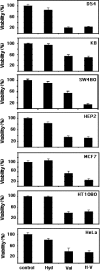Antineoplastic effects of the DNA methylation inhibitor hydralazine and the histone deacetylase inhibitor valproic acid in cancer cell lines
- PMID: 16448574
- PMCID: PMC1408081
- DOI: 10.1186/1475-2867-6-2
Antineoplastic effects of the DNA methylation inhibitor hydralazine and the histone deacetylase inhibitor valproic acid in cancer cell lines
Abstract
Background: Among the epigenetic alterations occurring in cancer, DNA hypermethylation and histone hypoacetylation are the focus of intense research because their pharmacological inhibition has shown to produce antineoplastic activity in a variety of experimental models. The objective of this study was to evaluate the combined antineoplastic effect of the DNA methylation inhibitor hydralazine and the histone deacetylase inhibitor valproic acid in a panel of cancer cell lines.
Results: Hydralazine showed no growth inhibitory effect on cervical, colon, breast, sarcoma, glioma, and head & neck cancer cell lines when used alone. On the contrary, valproic acid showed a strong growth inhibitory effect that is potentiated by hydralazine in some cell lines. Individually, hydralazine and valproic acid displayed distinctive effects upon global gene over-expression but the number of genes over-expressed increased when cells were treated with the combination. Treatment of HeLa cells with hydralazine and valproic acid lead to an increase in the cytotoxicity of gemcitabine, cisplatin and adriamycin. A higher antitumor effect of adriamycin was observed in mice xenografted with human fibrosarcoma cells when the animals were co-treated with hydralazine and valproic acid.
Conclusion: Hydralazine and valproic acid, two widely used drugs for cardiovascular and neurological conditions respectively have promising antineoplastic effects when used concurrently and may increase the antitumor efficacy of current cytotoxic agents.
Figures




Similar articles
-
Antimetastatic effect of epigenetic drugs, hydralazine and valproic acid, in Ras-transformed NIH 3T3 cells.Onco Targets Ther. 2018 Dec 7;11:8823-8833. doi: 10.2147/OTT.S187306. eCollection 2018. Onco Targets Ther. 2018. PMID: 30584338 Free PMC article.
-
Radiosensitization of cervical cancer cells with epigenetic drugs hydralazine and valproate.Eur J Gynaecol Oncol. 2014;35(2):140-2. Eur J Gynaecol Oncol. 2014. PMID: 24772915
-
The effects of DNA methylation and histone deacetylase inhibitors on human papillomavirus early gene expression in cervical cancer, an in vitro and clinical study.Virol J. 2007 Feb 26;4:18. doi: 10.1186/1743-422X-4-18. Virol J. 2007. PMID: 17324262 Free PMC article.
-
Up-regulation of HLA class-I antigen expression and antigen-specific CTL response in cervical cancer cells by the demethylating agent hydralazine and the histone deacetylase inhibitor valproic acid.J Transl Med. 2006 Dec 27;4:55. doi: 10.1186/1479-5876-4-55. J Transl Med. 2006. PMID: 17192185 Free PMC article.
-
Hydralazine-valproate: a repositioned drug combination for the epigenetic therapy of cancer.Expert Opin Drug Metab Toxicol. 2014 Oct;10(10):1433-44. doi: 10.1517/17425255.2014.947263. Epub 2014 Aug 25. Expert Opin Drug Metab Toxicol. 2014. PMID: 25154405 Review.
Cited by
-
Valproate inhibits colon cancer growth through cell cycle modification in vivo and in vitro.Exp Ther Med. 2011 Mar;2(2):301-307. doi: 10.3892/etm.2011.202. Epub 2011 Jan 20. Exp Ther Med. 2011. PMID: 22977502 Free PMC article.
-
Efficacy of anti-epileptic drugs in patients with gliomas and seizures.J Neurol. 2009 Sep;256(9):1519-26. doi: 10.1007/s00415-009-5156-9. Epub 2009 May 12. J Neurol. 2009. PMID: 19434440
-
Anti-neoplastic properties of hydralazine in prostate cancer.Oncotarget. 2014 Aug 15;5(15):5950-64. doi: 10.18632/oncotarget.1909. Oncotarget. 2014. PMID: 24797896 Free PMC article.
-
Valproic acid inhibits proliferation of HER2-expressing breast cancer cells by inducing cell cycle arrest and apoptosis through Hsp70 acetylation.Int J Oncol. 2015 Dec;47(6):2073-81. doi: 10.3892/ijo.2015.3213. Epub 2015 Oct 20. Int J Oncol. 2015. PMID: 26497673 Free PMC article.
-
Chromatin structure predicts epigenetic therapy responsiveness in sarcoma.Mol Cancer Ther. 2011 Feb;10(2):313-24. doi: 10.1158/1535-7163.MCT-10-0724. Epub 2011 Jan 7. Mol Cancer Ther. 2011. PMID: 21216937 Free PMC article.
References
-
- Aparicio A, Eads CA, Leong LA, Laird PW, Newman EM, Synold TW, Baker SD, Zhao M, Weber JS. Phase I trial of continuous infusion 5-aza-2'-deoxycytidine. Cancer Chemother Pharmacol. 2003;51:231–239. - PubMed
LinkOut - more resources
Full Text Sources
Other Literature Sources
Molecular Biology Databases

